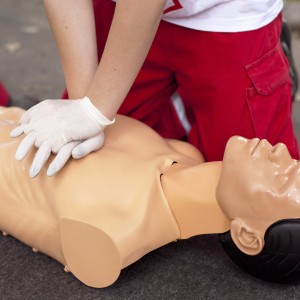 A review by physicians from UT Southwestern Medical Center’s Emergency Medicine division concluded that during a cardiopulmonary resuscitation (CPR) maneuver, the depth of chest compressions as well as the rate at which they are performed significantly influences patient’s survival and recovery outcome. The findings regarding the depth of chest compression were published in the journal Circulation, and the study entitled “What Is the Optimal Chest Compression Depth During Out-of-Hospital Cardiac Arrest Resuscitation of Adult Patients?” Findings concerning the rate of CPR compressions were published in the journal Critical Care Medicine in the study entitled “Chest Compression Rates and Survival Following Out-of-Hospital Cardiac Arrest.”
A review by physicians from UT Southwestern Medical Center’s Emergency Medicine division concluded that during a cardiopulmonary resuscitation (CPR) maneuver, the depth of chest compressions as well as the rate at which they are performed significantly influences patient’s survival and recovery outcome. The findings regarding the depth of chest compression were published in the journal Circulation, and the study entitled “What Is the Optimal Chest Compression Depth During Out-of-Hospital Cardiac Arrest Resuscitation of Adult Patients?” Findings concerning the rate of CPR compressions were published in the journal Critical Care Medicine in the study entitled “Chest Compression Rates and Survival Following Out-of-Hospital Cardiac Arrest.”
The 2010 American Heart Association CPR guidelines recommended chest compressions of at least 5 centimeters deep, without mentioning an upper limit. The common belief was that better results were obtained with deeper chest compressions.
Physicians now concluded by assessing a large cohort of out-of-hospital cardiac arrest patients that CPR compressions with a depth greater than 5.5 centimeters (approximately two inches) decrease patient survival, most likely due to the collateral damage inflicted in other internal organs. A depth interval of 4.03 to 5.53 centimeters (peak at 4.56 centimeters) was found to yield maximum survival.
“Most people do not recognize that it takes quite a bit of thrust to compress the chest 2 inches,” noted Dr. Ahamed Idris, Professor at UT Southwestern and Director of the Dallas-Fort Worth Center for Resuscitation Research, in a news release. “About 60 lbs. of pressure are required to reach this depth. But in some cases a burly fireman or well-intended volunteer can go way past that amount, which can harm the patient.”
Besides depth, the rate at which CPR compressions are performed is also essential. The team found that a rate of 100 to 120 compressions per minute proved to be associated with higher patient survival.
“Survival depends on the quality of the CPR,” said Dr. Idris. “Both the depth of chest compressions and the rate at which they are applied can have important results for patients in the first moments of cardiac arrest.”
Dr. Idris, who is also a trainer of paramedics, notes that approximately half of the individuals perform CPR compressions too fast, with usually one-third applying more than 120 compressions per minute and about 20 percent with a rate above the 140 compressions per minute. Curiously, the majority of the emergency responders found the beat of the “Row, Row, Row Your Boat” children’s song to actually be a good way to achieve the optimal 100 to 120 compressions per minute.
In a cardiac arrest situation where CPR intervention is required, the American Heart Association guidelines recommend two actions: to call 911 and to immediately perform chest compressions, and, according to Dr. Idris “don’t stop until the paramedics arrive.”


